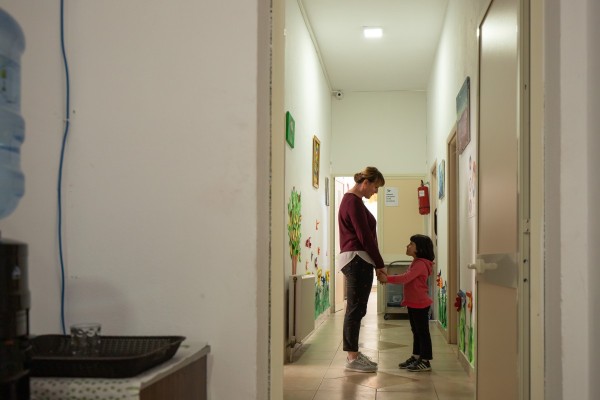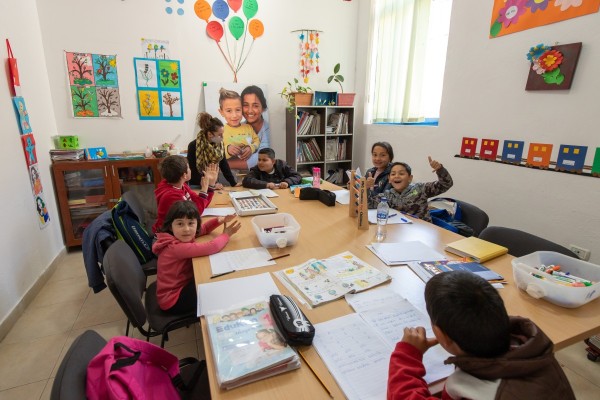Repository of Practices

Immediate support and emergency recovery for unaccompanied foreign and separated children (UASC) in the territory of Albania
Secondary GCM Objectives
Dates
Type of practice
Summary
Albania has increasingly become a transit country through which migrant children, often unaccompanied or separated by their caregivers, go through to reach their desired destination country in Europe. There is a lack of regulatory clarity and capacity with regard to case management of UASC, provision of shelter and support for their identification and assessment as well as the appointment of the legal guardian. This situation often leaves these children unprotected from violence, abuse, neglect, and exploitation and unable to benefit from appropriate care and services, and contributes to children moving onwards. Nisma ARSIS through the support of UNICEF provides emergency response service (shelter, support in police stations and emergency response in the street) at the national level for supporting the child protection system to offer direct assistance and services to children at high risk level, victims of abuse, exploitation, trafficking, violence, and including UASC in the territory of Albania. Since 2020, when the first big wave of UASC came in Albania, Nisma ARSIS was the only service provider who provided safe accommodation shelter in short term from 72 hours up to two months (emergency shelter) and protection services to UASC in Albania, contributing at the same time through field work and practice strengthening the child protection system to better respond to the cases of UASC. The main activities: included: - assist the State Agency for the Rights and Protection of the Child in the implementation of DCM instruction no.111 related to UASC and its revision for improvement; - drafting and apply standard operating procedures for UASC children's cases; - supporting and mentoring child protection units of border points and Tirana Municipality for the management of UASC cases to use child protection policies; - Safe emergency shelter for UASC.
Organizations
Main Implementing Organization(s)
Detailed Information
Partner/Donor Organizations
Benefit and Impact
The fulfillment of migrants' rights and the enhancement of their wellbeing are central outcomes of Nisma ARSIS's practice. By offering emergency response services, including shelter and support, the organization has safeguarded UASC from violence, abuse, and exploitation. Through this, the practice has not only provided immediate relief but also nurtured an environment where these children's physical and emotional needs are met.
The results achieved are noteworthy, more than 90 UASC has been supported in the accommodation shelter. Key accomplishments include the improved implementation of UASC-related regulations, the establishment of tailored standard operating procedures, and the strengthening of child protection units at border points and within Tirana Municipality. These outcomes signify a more comprehensive and effective child protection system.
Measurement of impacts is carried out through indicators such as the number of UASC provided with emergency support, the implementation rate of relevant policies, and the successful utilization of operating procedures. The practice's impacts have been observed progressively since 2020, with both short-term benefits and medium-to-long-term effects on policy implementation and capacity building.
Positive secondary benefits emerge from this practice, resonating beyond UASC and migrant populations. The strengthened child protection framework and enhanced policy implementation set a precedent for improved safeguards for vulnerable children and can inspire similar initiatives worldwide.
Given the ongoing challenges faced by UASC and the evident positive outcomes achieved, the practice's continuation beyond its initial end date is likely. The practice's impacts, encompassing protection, support, and policy enhancement, underscore its importance
Key Lessons
Main challenges during implementation:
- The lack of clear regulatory guidance posed challenges in providing consistent protection to UASC. The complexity of existing regulations required careful interpretation and implementation (revision of the Decision of Council of Minister no. 111)
- The initial identification and pre-screening of UASC at the border lacked coordination between Child Protection Workers (CPW) and other authorities, leading to discrepancies in the assessment process.
- Inconsistent coordination between CPW, border police, and the State Agency for the Rights and Protection of the Child (SARCP) hindered efficient case management. Delays in state authorities' responses impacted service provision and case resolution.
- Adequate resources, including funding and trained personnel, were limited. This hindered the organization's ability to scale up its services and respond effectively to the growing number of UASC.
How each challenge was overcome:
- Nisma ARSIS actively engaged with the State Agency for the Rights and Protection of the Child, contributing to the implementation of specific regulations (DCM instruction no.111) related to UASC.
- To address coordination gaps, Nisma ARSIS emphasized ongoing collaboration between CPW, border police, and SARCP. Regular communication and responsive interactions were facilitated through established channels, ensuring timely assistance for UASC cases. Reporting mechanisms to higher authorities were also established in case of unresponsiveness.
- Nisma ARSIS advocated for strengthened identification and pre-screening processes at the border in collaboration with CPW. The organization required timely assessment reports, including comprehensive details, before providing services, thus streamlining the initial stages of case management.
- Nisma ARSIS deployed experienced staff with security measures to cater to UASC needs without
- compromising the quality of care for other children in the shelter. This approach maintained a safe environment while addressing the diverse needs of all children.
- The organization leveraged partnerships with UNICEF and other stakeholders to secure additional funding and resources. In the same time a parliamentary session was requested to address the challenges was realised with the deputy group “Friends of Children”.
What could have been done differently:
- Earlier and more comprehensive engagement with stakeholders like CPW, border police, and SARCP could have facilitated smoother coordination and improved identification and pre-screening processes.
- Nisma ARSIS could have actively engaged in political advocacy from the outset to garner support and resources for addressing the specific context of UASC in Albania.
Recommendations(if the practice is to be replicated)
For organizations seeking to replicate Nisma ARSIS's successful practice in addressing the challenges of unaccompanied and separated migrant children (UASC) in Albania, several key recommendations can guide their efforts:
- Prioritize collaboration with Child Protection Workers (CPW) for robust identification and pre-screening processes at the border. Ensure that medical and psychological assessments are conducted during initial identification to inform appropriate case management.
- Foster responsive coordination among CPW, border police, and relevant state agencies throughout the case management process. This collaboration ensures timely and effective assistance for UASC cases.
- Develop safe emergency services staffed by experienced professionals and equipped with security measures. Strive to address UASC needs comprehensively while maintaining the quality of services for other vulnerable children in shelters.
- Participate in roundtable discussions and collaborative forums that address challenges encountered during case management. This proactive engagement facilitates the sharing of best practices and continuous improvement.
- Recognize the importance of political engagement in shaping effective responses to UASC contexts. Advocate for policies and resources that support the needs of UASC within the national framework.
- Advocate for the harmonization of relevant laws and bylaws, including those related to asylum, the rights and protection of children, and social care services. This harmonization enhances the legal foundation for UASC support.
- Prioritize capacity building for CPW and other professionals involved in UASC case management. Focus on equipping them with the necessary knowledge and skills related to UASC standard operating procedures.
- Foster collaboration among various service providers operating in the field, such as NGOs like Caritas, police, and CPW. Establish clear communication channels to collectively address UASC concerns.
Advice for Implementation:
- Successful implementation requires strong partnerships with governmental agencies, NGOs, and international bodies. Adequate funding and trained personnel are prerequisites for effective service delivery.
- A comprehensive understanding of the regulatory landscape, collaboration among stakeholders, and a dedicated and experienced team are critical factors for success.
- Design services to address both immediate needs and long-term wellbeing.
- Adapt the practice to the unique context of each country, considering factors such as local regulations, cultural sensitivities, and available resources.
- Evaluation: Regularly assess the impact of the practice by measuring indicators like the number of UASC served, successful coordination efforts, and policy improvements. Continuously refine strategies based on evaluation outcomes.
- Incorporating these recommendations and advice will assist organizations in implementing a practice
Innovation
Nisma ARSIS's practice in providing support to unaccompanied and separated migrant children (UASC) in Albania offers several innovative elements that contribute to its effectiveness in addressing a complex and pressing issue.
- The practice emphasizes thorough identification and pre-screening of UASC at the border, incorporating medical and psychological assessments during the first identification. This holistic approach ensures that the children's needs are promptly addressed from the outset.
- The coordination mechanism established among Child Protection Workers (CPW), border police, and the State Agency for the Rights and Protection of the Child (SARCP) is innovative. It ensures a seamless flow of information and actions, expediting case management within the intersectoral approach.
- Balancing the provision of safe emergency services for UASC while maintaining the quality of services for other vulnerable children accommodated in the shelter demonstrates an innovative approach to simultaneous care provision.
Catalyzing related initiatives:
- The practice has catalyzed collaborative efforts among various stakeholders, including governmental agencies, NGOs, and international organizations. Nisma ARSIS's proactive approach to addressing the challenges faced by UASC has inspired discussions, knowledge-sharing, and joint initiatives to enhance child protection systems and responses.
Sustainability of Impacts:
- The impacts of the practice have the potential for sustainability. Through policy advocacy, engagement with state authorities, and capacity-building efforts, the practice has contributed to regulatory improvements and the strengthening of the child protection system. These efforts, if sustained, can lead to lasting positive impacts on UASC.
Scalability:
- The practice exhibits scalability potential. Its foundational principles, such as collaborative coordination, comprehensive assessment, and adaptive response strategies, can be adapted and replicated in other contexts facing similar challenges with UASC. The practice's emphasis on effective partnerships and capacity-building aligns with the scalability of such initiatives.
Adaptation to the COVID-19 pandemic:
- The practice's focus on coordination and responsiveness proved valuable during the COVID-19 pandemic. Despite the pandemic's challenges, the established communication channels and coordination mechanisms allowed for timely adjustments. Safety measures, including the provision of secure services and health assessments, were incorporated to safeguard both UASC and staff members. The safe accommodation center was the only one social care facility open and operational during the COVID-19 pandemic.
In summary, Nisma ARSIS's practice exhibits innovation through its novel processes, collaborative coordination, and dual-focused care provision. Its potential to catalyze related initiatives, sustainable impacts, scalability, and adaptability.
Additional Resources
Additional Images
Date submitted:
Disclaimer: The content of this practice reflects the views of the implementers and does not necessarily reflect the views of the United Nations, the United Nations Network on Migration, and its members.
More Related Practices:
- Ministerio de Salud: Integrando las necesidades de salud de la población migrante y refugiada en el Perú
- Comité de Familiares de Migrantes Desaparecidos de el Progreso, Yoro, Honduras, COFAMIPRO 25 años dando la lucha en la búsqueda de personas migrantes
- Migrant Response and Resources Mechanism in Niger
- Ocean Viking - Cooperation between SOS MEDITERRANEE and IFRC for Search and Rescue and Post-Rescue Assistance and Relief
- Cooperation between Red Cross and Red Crescent National Societies and their Governments to provide humanitarian assistance and protection
Peer Reviewer Feedback:
*References to Kosovo shall be understood to be in the context of United Nations Security Council resolution 1244 (1999).
Newsletter
Subscribe to our newsletter.




